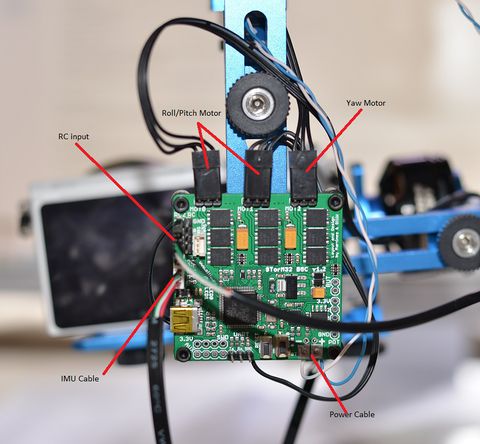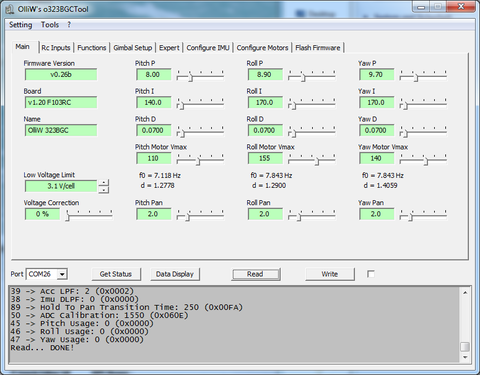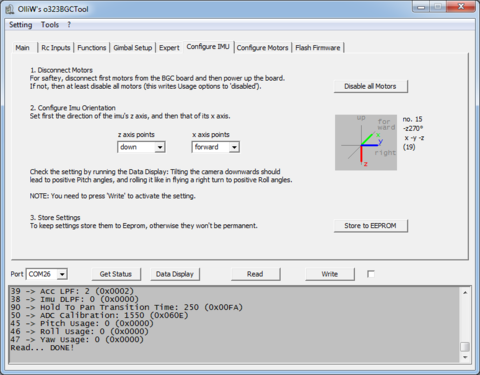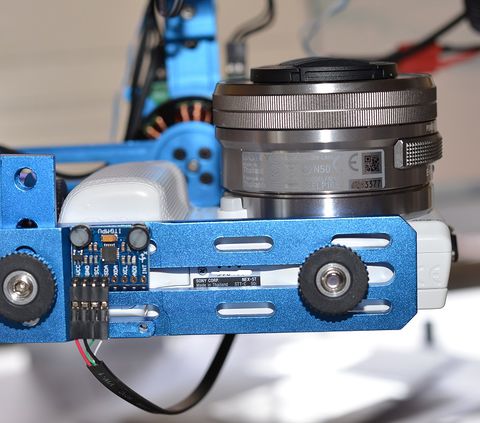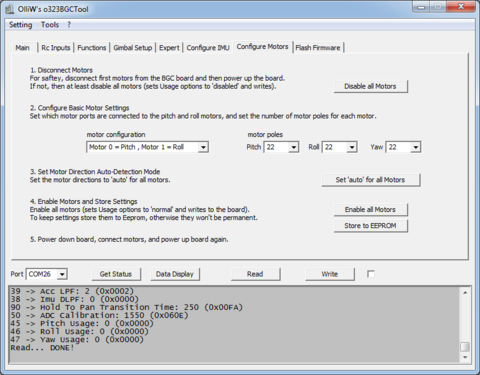Getting Started
Werner: I habe die letzte 1/2 h am English gearbeit, lass mich das kurz saven befor du weitermachst, OK?
Foreword
This page is intended to help you making the first steps with the gimbal controller. Every gimbal is unique because of different size, motors, and camera weight. Copying the configuration of one gimbal to another won't work. You have to learn what happens with your gimbal when changing settings. If you're not prepared to invest the time the STorM32BGC, like any other gimbal controllers, won't make you happy :-). Otherwise, let's get started...
Parts Checklist
- 1x STorM32BGC
- 1x MPU6050 breakout board (plus 4pol cable and plug to connect to the controller)
- 1x 3 axis gimbal with motors
- 3x motor cable (each 3pol)
- 1x Lipo 2s - 4s (plus 2pol cable and plug to connect to the controller)
- 1x USB 2.0 cable
- firmware and gui, Downloads
- 1x USB to serial adapter + 4 dupont 2.54mm cables (necessary for firmware update or first flashing)
- 1x joystick + 5 dupont 2.54mm cables (OPTIONAL)
- 1x IR led + 2 dupont 2.54mm cables (OPTIONAL)
- plenty of time and patience ;-)
For possible sources for some parts you may check out Where to buy accessories and supplies.
The Gimbal
Before you power up any electronics it is absolutely necessary to balance your gimbal and to ensure minimum resistance to rotations (friction in bearings, stiff cables, etc). Any unbalance or distraction to free rotation will make setting up the gimbal much more difficult or even not possible. The goal is that no matter where your camera, mounted in the gimbal, points to, it should remain in that position. You do not have to do a perfect job but the better it gets, the less energy the motors will have to apply to keep the camera in position.
Connectors
In order to operate the gimbal the first time, the only cables required are
- Connecting the IMU with the controller - without that the controller will show errors and not power up the motors
- Connecting the motors with the controllers - Mot0 and Mot1 are meant for Roll and Pitch (which is what is defined in the GUI) and Mot2 for the Yaw motor. The order of the three cables is f no importance as we have not set the motor direction in the GUI yet.
- USB port connected to the computer for setup and debugging purposes
- Power connector obviously - power provided by USB allows not for enough current to power up even the smallest motors
The RC connection may remain disconnected for now, then the gimbal will compensate all movements only.
First Configuration
Assuming the controller is ready and firmware was uploaded already, when you power up the gimbal and connect it via USB to the computer the first time, nothing much will happen. The two LEDs will blink with various frequencies and the gimbal can be moved freely as no power is applied to the motors yet. Now you start the configuration GUI matching the controller's firmware version and at the bottom left you select the COM port used by the USB controller. If you are not certain which one it is, unplug the USB cable, open the Windows device manager (enter devmgmt.msc in the search box of Windows) and expand the Port node. When you plugin the USB cable again, one additional entry will show up. Once the proper COM port is selected, the first thing to do is hitting the Read button. If everything was in order, the GUI will read from the controller the currently stored settings and in the text box at the bottom you can see some messages and a final Read...DONE! text.
Now it is time to set the most important parameters, that is the IMU orientation and the motor values.
IMU Orientation
The tab called Configure IMU is meant to support you setting the IMU orientation correctly. There are so many different way you can attach the IMU to your camera, above the camera, below, at the backside and for each mounting location it could be with the axis up, down, left, right. The controller does not know that, you have to tell.
The first thing to do is clicking on the Disable all Motors botton to avoid any motor movements. Now we investigate the camera. The z-axis points outwards of the surface of the IMU chip, in this example here it points downwards the camera. So you specify the z-axis to point down. The x axis is a bit more hairy. First we don't know which edge of the chip means x, which one is y. And second we don't know the direction. For the edge the IMU board has an arrow printed on it and labelled as x. In the example below the x-axis points along the same line as the camera axis, so the x-axis points either front of the camera or to the back. In order to find the direction, the IMU has a little white dot in one corner. This dot represents the end position of the arrow. Therefore we now know the x-axis is the left side of the chip and it points to the camera's back side - this is what we select: x axis points to back.
This setting should be sent to the board, so you click on the Write button. To also make the changes permanently - the button Store to EEPROM is used. Alternatively you can click on write only to update the controlled without making the change permanent. Or tick the checkbox next the Write button, then the label of the button turns into Write+Store, well, to store the values to the EEPROM. All methods are fine.
Please note that this Configure IMU page is for your help only. It shows the orientation index, here no. 13, and this value is then written into the Gimbal Setup tab.
If you are uncertain about the settings, you can write the data (temporary or into EEPROM) and then click on the Data Display button. This will show you a realtime monitor window and at the top you can see the current values of the Pitch, Roll (and Yaw) once you did click on Start in that window.
As the motors are disabled still, you can tilt the camera pointing upwards and the Pitch value should get more positive. Assume you are flying a left turn, the Roll value should get more positive.
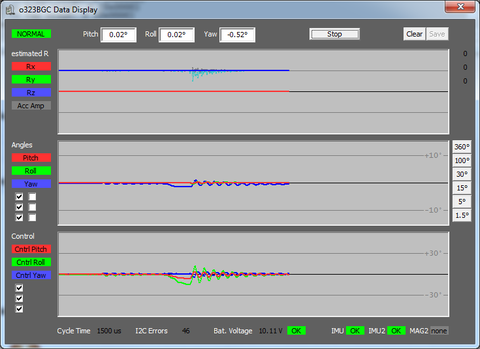
Motor Settings
For the motor settings there is a separate tab as well, the Configure Motors. Again, you disable the motors first by using the appropriate button and then you select the motor configuration. In my example the Mot0 port of the controller is connected to the motor which lets the camera look up or down, it is the pitch motor. And Mot1 is connected to the Roll motor, the one keeping the horizon level. Remember, Mot2 is used for Yaw always. The motor poles are best read from the motor's datasheets found in the internet. The last setting is the motor direction but for that there is a auto setting available. Then the init phase of the gimbal takes one second longer - who cares. With these few steps you updated the proper fields in the Gimbal Setup tab and should be ready to go.
Next step - PID Tuning
Once you completed above, the motors likely need to be turned on again. In the Expert tab the Pitch Usage/Roll Usage/Yaw Usage are all to be altered from disabled to normal and saved to EEPROM by ticking the checkbox next to the Write button and then Write+Store the values. Now the Gimbal might work, or start shaking weird or make high frequency noises. These would be the effects of sub optimal PID values in the Main tab for Pitch/Roll/Yaw. See the PID parameters chapter for adjusting those.
